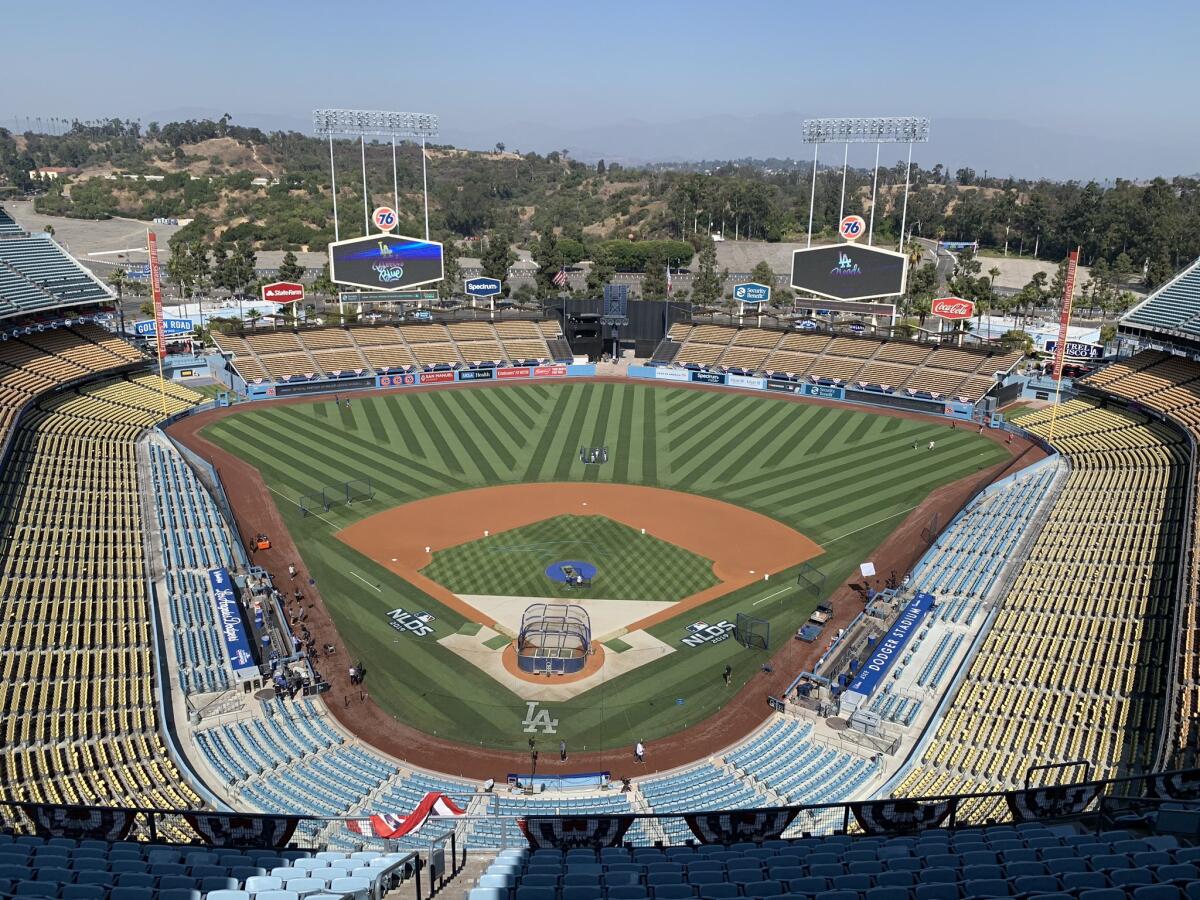Dodgers Dugout: You will be able to attend Dodger games this season

Hi, and welcome to another edition of Dodgers Dugout. My name is Houston Mitchell, and fans will be able to attend Dodger games this season. And there was much rejoicing throughout the land.
When the Dodgers receive their World Series rings and the championship banner is raised, there will be fans there to witness it.
Are you a true-blue fan?
Get our Dodgers Dugout newsletter for insights, news and much more.
You may occasionally receive promotional content from the Los Angeles Times.
On Friday, Los Angeles county received approval to move into the red tier of the state’s coronavirus guidelines, allowing the Dodgers to sell 20% of the seats in their ballparks. That would be approximately 11,000 fans at each game.
Enjoying this newsletter?
Your support helps us deliver the news that matters most. Become a Los Angeles Times subscriber.
How will you be able to get a ticket? We don’t know yet, but the Dodgers said they would announce guidelines this week (we will report it in this newsletter as soon as possible after that). Priority for tickets will be given to season-ticket holders, which means there may not be a lot of tickets available for regular folks, unless you want to pay the high prices expected on resale vendors.
So, soon the scrambling for tickets will begin, and hopefully by the end of the season Dodger Stadium will be operating at full capacity.
Killing the shift
Big changes could be coming. MLB announced a few rules changes they will be testing in the minors this season, one of them designed to weaken the defensive shift that many blame for making baseball less exciting by eliminating singles and long rallies and making batters go for home runs. Let’s run down those changes:
Triple-A changes
Base size will increase from 15 inches each side to 18 inches. The theory is this will help increase stolen bases and decrease collisions at second base on double-play attempts. Note this is just the bases, as home plate remains the same size.
Double-A changes
The first baseman, second baseman, shortstop and third baseman will be required to have both feet completely in front of the outer infield dirt boundary when the pitch is delivered.
Theory: This will prevent the second baseman from playing in shallow right and fielding hard hit balls hit there. It should increase the amount of base hits in games.
If this rule is successful, it may lead to another change in the second half of the double-a season: The shortstop and third baseman have to remain on the left side of the infield, and the second baseman and first baseman remain on the right side before the pitcher pitches.
High Class A league
Pitchers must fully step off the rubber before attempting a pickoff throw at first base.
Theory: This will allow runners to take a bigger lead and increase the amount of stolen bases.
Low Class A league
Pitchers get just two pickoff attempts per plate appearance. On the third attempt, if the runner is not thrown out, the move is ruled a balk and any runners are automatically awarded the next base.
Theory: Speed up the game and more stolen bases.
Low Class A (west)
A 15-second pitch clock. One timer will be located in the outfield and two behind home plate, between the dugouts. Inning breaks and pitching changes will also be timed. What was once the California League is now called the Low-A West league.
Theory: This will speed up the game.
Low Class A (southeast)
Instead of an umpire, the Hawk-Eye tracking system will call balls and strikes. There will still be an umpire behind home plate, but he will receive and audio signal from Hawk-Eye and then make the call.
Theory: Improve accuracy of ball and strike calls.
As far as trying to prevent shifts, keep in mind the Dodgers called for more shifts than any other team last season, using a shift 1,209 times.
“I do like the way [MLB is] being aggressive in if there’s thoughts that Major League Baseball wants to implement and try to make it happen as soon as possible to see how it plays out,” Dave Roberts said. “I do think that we will get more intel once the Double-A season is played out. And as far as my thoughts on the shift or no shift, I really don’t have any preference. I really don’t. Whatever is implemented, I’m all for.”
“Within those parameters, we’re going to do everything we can to get to gain that competitive advantage within the rules. I think that we shift as aggressive as anyone and we convert balls in play into outs.”
Farewell to Stan Williams and Norm Sherry
Former Dodger pitcher Stan Williams died in February at the age of 84 after battling a cardiopulmonary illness.
Bill Plaschke wrote about Williams in 2018. An excerpt:
“Stan Williams threw to 7,521 batters in a career he believes has been defined by only one — Jim Davenport, San Francisco Giants, 1962, ninth inning, bases loaded.
“Threw him a strike down the middle, he took it,’’ Williams says.
It was a pennant-deciding playoff game between the Dodgers and Giants. The score was tied 4-all. Williams had been summoned from the bullpen to save a season, drive a stake through a rival, and help send the Dodgers to the World Series.
With a count of two balls and one strike, he lost it all.
“Threw him two more balls, and that was it,’’ Williams says, shaking his head. “Walked him. Walked in the winning run. That’s how I’ll be remembered.’’
Stan Williams stretches his 6-foot-5-inch frame across a recliner, tightens his jaw and offers weathered proof that it’s not always so easy.
“People don’t always remember what you did,’’ he says. “They remember what you didn’t do.’’
Williams did plenty. For most of the Dodgers’ first five years in Los Angeles, he was an integral part of a famed starting rotation that included Sandy Koufax, Don Drysdale and Johnny Podres. Williams literally pitched them into the World Series in 1959 by finishing a 12-inning playoff win against the Milwaukee Braves with three scoreless innings. He was one of the players who dug the groundbreaking holes for Dodger Stadium before becoming one of its first occupants in 1962.
“Along with Drysdale, Stan was my protector,’’ says Maury Wills. “When other pitchers would come close to me, Stan would come to me and say, ‘Don’t worry, I’ll get him for you,’ and he would drill the guy.’’
————
Norm Sherry, 89, died last week. He was a catcher for the Dodgers from 1959-62 and the brother of pitcher Larry Sherry. And he may be responsible for turning around Sandy Koufax’s career.
Sherry was catching Koufax one afternoon during a spring training game in 1961. It was a split squad, so the Dodgers were somewhat shorthanded and needed Koufax to pitch a few innings. But he was throwing as hard as he could on every pitch, like always, and the ball was going everywhere except where he wanted, like always.
Sherry went out to the mound and said, “At this rate, you’re going to be out here all day. Why don’t you take something off the ball? Don’t even try and strike these next guys out. Just throw it over the plate and let them hit it.
“So I go back behind the plate, and lo and behold, he did it. He wound up nice and easy, like he was saying, ‘Here, hit it.’ He tried to ease up, and he was throwing harder than when he tried to. And I guess the light bulb just went off in his head.”
Another opening day start for Clayton Kershaw
Dave Roberts announced Sunday that Clayton Kershaw will get his ninth opening day start for the Dodgers when L.A. takes on the Colorado Rockies in Denver.
Most opening day starts for the Dodgers:
Clayton Kershaw, 9
Don Sutton, 7
Don Drysdale, 7
Fernando Valenzuela, 6
Ramon Martinez, 5
Carl Erskine, 4
Van Lingle Mungo, 4
Nap Rucker, 4
Orel Hershiser, 4
Note: Sandy Koufax only had one opening day start for the Dodgers.
Dodgers tweets of the week
Spring training stats
After multiple requests, here are some spring training hitting stats, through Sunday:
Keibert Ruiz, 1.000 (2 for 2)
Corey Seager, .429 (9 for 21, 4 homers)
Sheldon Neuse, .412 (7 for 17)
Gavin Lux, .381 (8 for 21)
Zach McKinstry, .375 (6 for 16)
Matt Beaty, .333 (6 for 18)
Mookie Betts, .313 (5 for 16)
Chris Taylor, .294 (5 for 17, 2 homers)
Austin Barnes, .286 (4 for 14, 1 homer)
Will Smith, .278 (5 for 18)
DJ Peters, .267 (4 for 15, 2 homers)
Matt Davidson, .250 (4 for 16, 1 homer)
Justin Turner, .222 (4 for 18)
Edwin Rios, .154 (2 for 13)
AJ Pollock, .143 (3 for 21)
Max Muncy, .111 (2 for 18, 1 homer)
Joc and Kiké are red-hot
Joc Pederson, now with the Chicago Cubs, is 11 for 19 this spring with two doubles and five homers. Kiké Hernández is six for 15 for Boston with three doubles and a homer.
And finally
Back by request, Danny Kaye‘s Dodgers song. Listen here.
Until next time...
Have a comment or something you’d like to see in a future Dodgers newsletter? Email me at houston.mitchell@latimes.com, and follow me on Twitter at @latimeshouston. To get this newsletter in your inbox, click here.
Go beyond the scoreboard
Get the latest on L.A.'s teams in the daily Sports Report newsletter.
You may occasionally receive promotional content from the Los Angeles Times.




